Effect of Underground Coal Mining on the Regional Soil Organic Carbon Pool in Farmland in a Mining Subsidence Area
Abstract
1. Introduction
2. Materials and Methods
2.1. Description of the Study Area
2.2. Method for Evaluating the Effect of Coal Mining on the Soil Organic Carbon (SOC) Pool in Farmland in Jiuli Mining Subsidence Area
2.3. Sampling
2.4. Model for Estimating the SOC Density and SOC Storage in the Regional SOC Pool in Farmland in the Mining Subsidence Area
2.5. Evaluation of Estimation Precision
2.6. Carbon Storage in the Regional SOC Pool in Farmland without Coal Mining Effects in At0
3. Results
3.1. Geostatistical Results for the Outside Soil Samples
3.2. Spatial Distribution of SOC Density and SOC Storage in the Mining Subsidence Area (SOC Density and SOC Storage in At)
3.3. Evaluation of the Effects of Underground Coal Mining on the Regional SOC Pool in Farmland in the Mining Subsidence Area
4. Discussion
4.1. Geostatistical Analysis on the Spatial Variability of SOC in the Mining Subsidence Area
4.2. Reason for SOC Density Decrease in the Non-Waterlogged Subsidence Farmland and Seasonally Waterlogged Subsidence Farmland
4.3. Reason for SOC Density Decrease in Mining-Industrial Land and Water Bodies Created by Mining
4.4. Reason for SOC Density Increase in the Waterlogged Wetland Area
4.5. SOC Density Changes in the Whole Mining Subsidence Area
4.6. Applicability of the Models
5. Conclusions
Author Contributions
Funding
Conflicts of Interest
References
- Djerejian, E.P. The B.P. Statistical Review of World Energy. Available online: http://www.bp.com/content/dam/bp/pdf/Energy-economics/statistical-review-2018/BP-statistical-review-of-world-energy-2018-full-report.pdf (accessed on 9 October 2018).
- Hu, Z.; Xiao, W. Optimization of concurrent mining and reclamation plans for single coal seam: A case study in northern Anhui, China. Environ. Earth Sci. 2013, 68, 1247–1254. [Google Scholar] [CrossRef]
- Peng, S.P. Study on control and improvement of ecological environment in coal mine area in Western China. Sci. Technol. Rev. 2000, 27, 3. [Google Scholar]
- Shrestha, R.K.; Lal, R. Changes in physical and chemical properties of soil after surface mining and reclamation. Geoderma 2011, 161, 168–176. [Google Scholar] [CrossRef]
- Silburn, D.M.; Crow, F.R. Source: Transactions of the American Society of Agricultural Engineers. Am. Soc. Agric. Eng. 1984, 27, 827–832. [Google Scholar]
- Cole, C.; Duxbury, J.; Freney, J.; Heinemeyer, O.; Minami, K.; Mosier, A.; Paustian, K.; Rosenberg, N.; Sampson, N.; Sauerbeck, D.; et al. Global estimates of potential mitigation of greenhouse gas emissions by agriculture. Nutr. Cycl. Agroecosyst. 1997, 49, 221–228. [Google Scholar] [CrossRef]
- Lal, R. Carbon management in agricultural soils. Mitig. Adapt. Strateg. Glob. Chang. 2007, 12, 303–322. [Google Scholar] [CrossRef]
- Snyder, C.; Bruulsema, T.; Jensen, T.; Fixen, P. Review of greenhouse gas emissions from crop production systems and fertilizer management effects. Agric. Ecosyst. Environ. 2009, 133, 247–266. [Google Scholar] [CrossRef]
- Tubiello, F.N.; Schmidhuber, J. Emissions of greenhouse gases from agriculture and their mitigation. Handb. Food Demand Supply Sustain. Secur. 2014, 56, 422–430. [Google Scholar]
- Maharaj, S.; Barton, C.D.; Karathanasis, T.A.; Rowe, H.D.; Rimmer, S.M. Distinguishing “new” from “old” organic carbon on reclaimed coal mine sites using thermogravimetry: I. Method development. Soil Sci. 2007, 172, 292–301. [Google Scholar] [CrossRef]
- Brye, K.R. Soil Biochemical Properties as Affected by Land Leveling in a Clayey Aquert. Soil Sci. Soc. Am. J. 2006, 70, 1129–1139. [Google Scholar] [CrossRef]
- Hetrick, B.; Wilson, G.; Figge, D. The influence of mycorrhizal symbiosis and fertilizer amendments on establishment of vegetation in heavy metal mine spoil. Environ. Pollut. 1994, 86, 171–179. [Google Scholar] [CrossRef]
- Meng, L.; Feng, Q.-Y.; Zhou, L.; Lu, P.; Meng, Q.-J. Environmental cumulative effects of coal underground mining. Procedia Earth Planet. Sci. 2009, 1, 1280–1284. [Google Scholar] [CrossRef]
- Izaurralde, R.C. Cycles of soil. Crop Sci. 2000, 40, 288. [Google Scholar] [CrossRef]
- Shrestha, R.K.; Lal, R. Ecosystem carbon budgeting and soil carbon sequestration in reclaimed mine soil. Environ. Int. 2006, 32, 781–796. [Google Scholar] [CrossRef] [PubMed]
- González-Pérez, J.A.; González-Vila, F.J.; Almendros, G.; Knicker, H. The effect of fire on soil organic matter—A review. Environ. Int. 2004, 30, 855–870. [Google Scholar] [CrossRef] [PubMed]
- Zhang, G.S.; Ni, Z.W. Winter tillage impacts on soil organic carbon, aggregation and CO2 emission in a rained vegetable cropping system of the mid–Yunnan plateau, China. Soil Tillage Res. 2017, 165, 294–301. [Google Scholar] [CrossRef]
- XCMG. Mine Designed of Xuzhou Coal Mining Group; China University of Mining and Technology Press: Xuzhou, China, 2008. [Google Scholar]
- XCMG. Land Resources Invested of Xuzhou Coal Mining Group; China University of Mining and Technology Press: Xuzhou, China, 2008. [Google Scholar]
- Paradelo, R.; Virto, I.; Chenu, C. Net effect of liming on soil organic carbon stocks: A review. Agric. Ecosyst. Environ. 2015, 202, 98–107. [Google Scholar] [CrossRef]
- Haddaway, N.R.; Hedlund, K.; Jackson, L.E.; Kätterer, T.; Lugato, E.; Thomsen, I.K.; Isberg, P.E. How does tillage intensity affect soil organic carbon? A systematic review protocol. Environ. Evid. 2016, 5, 1. [Google Scholar] [CrossRef]
- Vindušková, O.; Frouz, J. Soil carbon accumulation after open-cast coal and oil shale mining in Northern Hemisphere: A quantitative review. Environ. Earth Sci. 2013, 69, 1685–1698. [Google Scholar] [CrossRef]
- Falahatkar, S.; Hosseini, S.M.; Ayoubi, S. Predicting soil organic carbon density using auxiliary environmental variables in northern Iran. Arch. Agron. Soil Sci. 2016, 62, 375–393. [Google Scholar] [CrossRef]
- Pei, W.; Yao, S.; Knight, J.F.; Dong, S.; Pelletier, K.; Rampi, L.P.; Wang, Y.; Klassen, J. Mapping and detection of land use change in a coal mining area using object-based image analysis. Environ. Earth Sci. 2017, 76, 125. [Google Scholar] [CrossRef]
- Shi, Z.; Li, Y. Application of Geostatistics in Soil Science; China Agriculture Press: Beijing, China, 2006. [Google Scholar]
- Lei, Z.D.; Yang, S.X. Soil Hydrodynamics; Tsinghua University Press: Beijing, China, 1988. [Google Scholar]
- Zhang, Z.; Yu, D.; Shi, X.; Weindorf, D.; Sun, W.; Wang, H.; Zhao, Y. Effects of prediction methods for detecting the temporal evolution of soil organic carbon in the Hilly Red Soil Region, China. Environ. Earth Sci. 2011, 64, 319–328. [Google Scholar] [CrossRef]
- Ghosh, S.; Scharenbroch, B.C.; Ow, L.F. Soil organic carbon distribution in roadside soils of Singapore. Chemosphere 2016, 165, 163–172. [Google Scholar] [CrossRef] [PubMed]
- Wang, S.; Fan, J.; Zhong, H.; Li, Y.; Zhu, H.; Qiao, Y.; Zhang, H.A. Multi-factor weighted regression approach for estimating the spatial distribution of soil organic carbon in grasslands. Catena 2019, 174, 248–258. [Google Scholar] [CrossRef]
- Kempen, B.; Dalsgaard, S.; Kaaya, A.K.; Chamuya, N.; Ruipérez-González, M.; Pekkarinen, A.; Walsh, M.G. Mapping topsoil organic carbon concentrations and stocks for Tanzania. Geoderma 2019, 337, 164–180. [Google Scholar] [CrossRef]
- Álvaro-Fuentes, J.; Gabriel, J.L.; Gutiérrez, C.; Nanos, N.; Escuer, M.; Ramos-Miras, J.J.; Gil, C.; Martín-Lammerding, D.; Boluda, R. Soil organic carbon stock on the Majorca Island: Temporal change in agricultural soil over the last 10 years. Catena 2019, 181, 221–230. [Google Scholar]
- Walkley, A.; Black, I.A. An examination of the degtjareff method for determining soil organic matter, and a proposed modification of the chromic acid titration method. Soil Sci. 1934, 37, 29–38. [Google Scholar] [CrossRef]
- Howard, P.J.A.; Howard, D.M. Use of organic carbon and loss-on-ignition to estimate soil organic matter in different soil types and horizons. Boil. Fertil. Soils 1990, 9, 306–310. [Google Scholar] [CrossRef]
- Wang, J.; Zhu, L.; Wang, Y.; Gao, S.; Daut, G. A comparison of different methods for determining the organic and inorganic carbon content of lake sediment from two lakes on the Tibetan Plateau. Quat. Int. 2012, 250, 49–54. [Google Scholar] [CrossRef]
- Wang, X.; Chow, J.C.; Kohl, S.D.; Percy, K.E.; Legge, A.H.; Watson, J.G. Characterization of PM2.5 and PM10 fugitive dust source profiles in the Athabasca Oil Sands Region. J. Air Waste Manag. Assoc. 2015, 65, 1421–1433. [Google Scholar] [CrossRef]
- Xu, Z.J.; Zhang, Y.; Zhang, S.L. Spatial prediction of soil organic carbon content in coal mining subsidence area based on GIS and partition kriging. Trans. Chin. Soc. Agric. Eng. 2018, 34, 253–259. [Google Scholar]
- Liu, T.L.; Juang, K.W.; Lee, D.Y. Interpolating soil properties using kriging combined with categorical information of soil maps. Soil Sci. Soc. Am. J. 2006, 70, 1200–1209. [Google Scholar] [CrossRef]
- Zhang, Z.; Yu, D.; Shi, X.; Weindorf, D.C.; Wang, X.; Tan, M. Effect of sampling classification patterns on SOC variability in the red soil region, China. Soil Tillage Res. 2010, 110, 2–7. [Google Scholar] [CrossRef]
- Guo, X.D.; Fu, B.J.; Chen, L.D.; Ke, M.A.; Li, J.R. The spatio-temporal variability of soil nutrients in Zunhua plain of Hebei province semivariogram and kriging analysis. Acta Geogr. Sin. 2000, 55, 555–566. [Google Scholar]
- Nakagawa, S.; Schielzeth, H. A general and simple method for obtaining R2 from generalized linear mixed-effects models. Methods Ecol. Evol. 2013, 4, 133–142. [Google Scholar] [CrossRef]
- Li, L.; Wu, K.; Zhou, D.-W. Extraction algorithm of mining subsidence information on water area based on support vector machine. Environ. Earth Sci. 2014, 72, 3991–4000. [Google Scholar] [CrossRef]
- Li, L.; Wu, K.; Zhou, D.-W. Evaluation theory and application of foundation stability of new buildings over an old goaf using longwall mining technology. Environ. Earth Sci. 2016, 75, 763. [Google Scholar] [CrossRef]
- Van Beers, W.C.M.; Kleijnen, J.P.C. Kriging for interpolation in random simulation. J. Oper. Res. Soc. 2003, 54, 255–262. [Google Scholar] [CrossRef]
- Mueller, T.G.; Pusuluri, N.B.; Mathias, K.K.; Cornelius, P.L.; Barnhisel, R.I.; Shearer, S.A. Map Quality for Ordinary Kriging and Inverse Distance Weighted Interpolation. Soil Sci. Soc. Am. J. 2004, 68, 2042. [Google Scholar] [CrossRef]
- Wang, Y.; Zhang, X.; Huang, C. Spatial variability of soil total nitrogen and soil total phosphorus under different land uses in a small watershed on the Loess Plateau, China. Geoderma 2009, 150, 141–149. [Google Scholar] [CrossRef]
- Meng, L.; Feng, Q.Y.; Wu, K.; Meng, Q.J. Quantitative evaluation of soil erosion of land subsided by coal mining using RUSLE. Int. J. Min. Sci. Technol. 2012, 22, 7–11. [Google Scholar] [CrossRef]
- Yang, G.; Bo, Z.; Pei, Z.; Tang, J.L.; Tao, W.; Miao, C.Y. Effects of vegetation cover on phosphorus loss from a hill slope cropland of purple soil under simulated rainfall: A case study in China. Nutr. Cycl. Agroecosyst. 2009, 85, 263–273. [Google Scholar]
- Cheng, J.X.; Nie, X.J.; Liu, C.H. Spatial variation of soil organic carbon in coal-mining subsidence areas. J. China Coal Soc. 2014, 39, 2495–2500. [Google Scholar]
- Zhang, L.; Wang, J.; Bai, Z.; Lv, C. Effects of vegetation on runoff and soil erosion on reclaimed land in an opencast coal-mine dump in a loess area. Catena 2015, 128, 44–53. [Google Scholar] [CrossRef]
- Zhang, Z.; Bai, Z.K.; He, Z.; Bao, N. Dynamic changes of land use type and carbon sinks based RS and GIS in Pingshuo opencast coal mine. Trans. China Soc. Agric. 2012, 28, 230–236. [Google Scholar]
- Wang, J.; Jiao, Z.; Bai, Z. Changes in carbon sink value based on RS and GIS in the Heidaigou opencast coal mine. Environ. Earth Sci. 2014, 71, 863–871. [Google Scholar] [CrossRef]
- Hu, Y.; Du, Z.; Wang, Q.; Li, G. Combined deep sampling and mass-based approaches to assess soil carbon and nitrogen losses due to land use changes in karst area of southwestern China. Solid Earth Discuss. 2016, 7, 1075–1084. [Google Scholar] [CrossRef]
- Zheng, Y.M.; Niu, Z.G.; Peng, G.; Dai, Y.J.; Wei, S. Preliminary estimation of the organic carbon pool in China’s wetlands. Sci. Bull. 2013, 58, 662–670. [Google Scholar] [CrossRef]
- Heikkinen, J.P.; Elsakov, V.; Martikainen, P.J. Carbon dioxide and methane dynamics and annual carbon balance in tundra wetland in NE Europe, Russia. Glob. Biogeochem. Cycles 2002, 16, 61–62. [Google Scholar] [CrossRef]
- Fenner, N.; Freeman, C.; Reynolds, B. Observations of a seasonally shifting thermal optimum in peatland carbon-cycling processes; implications for the global carbon cycle and soil enzyme methodologies. Soil Boil. Biochem. 2005, 37, 1814–1821. [Google Scholar] [CrossRef]
- Agus, C.; Putra, P.B.; Faridah, E.; Wulandari, D.; Napitupulu, R.R. Organic Carbon Stock and their Dynamics in Rehabilitation Ecosystem Areas of Post Open Coal Mining at Tropical Region. Procedia Eng. 2016, 159, 329–337. [Google Scholar] [CrossRef][Green Version]
- Amichev, B.Y.; Burger, J.A.; Rodrigue, J.A. Carbon sequestration by forests and soils on mined land in the Midwestern and Appalachian coalfields of the U.S. For. Ecol. Manag. 2008, 256, 1949–1959. [Google Scholar] [CrossRef]
- Xu, Z.; Zhang, S.; Hou, H.P. Research on the Effect of Coal Mining on Carbon Reserves of Farmland Soil: Taking the Typical Coal Mining Subsidence Basin as a Case. Mod. Min. 2014, 29, 1850–1855. [Google Scholar]
- Hou, H.P.; Zhang, S.L.; Ding, Z.Y.; Ma, C.Z.; Huang, A. Impact on vegetation carbon storage in ecosystem from land use change in coal mine area: A case study at Chacheng Mine in Xuzhou mining area. J. China Coal Soc. 2013, 38, 1850–1855. [Google Scholar]
- Kumar, S.; Lal, R.; Liu, D. A geographically weighted regression kriging approach for mapping soil organic carbon stock. Geoderma 2012, 189, 627–634. [Google Scholar] [CrossRef]
- Huang, Y.; Tian, F.; Wang, Y.; Wang, M.; Hu, Z. Effect of coal mining on vegetation disturbance and associated carbon loss. Environ. Earth Sci. 2015, 73, 1–14. [Google Scholar] [CrossRef]
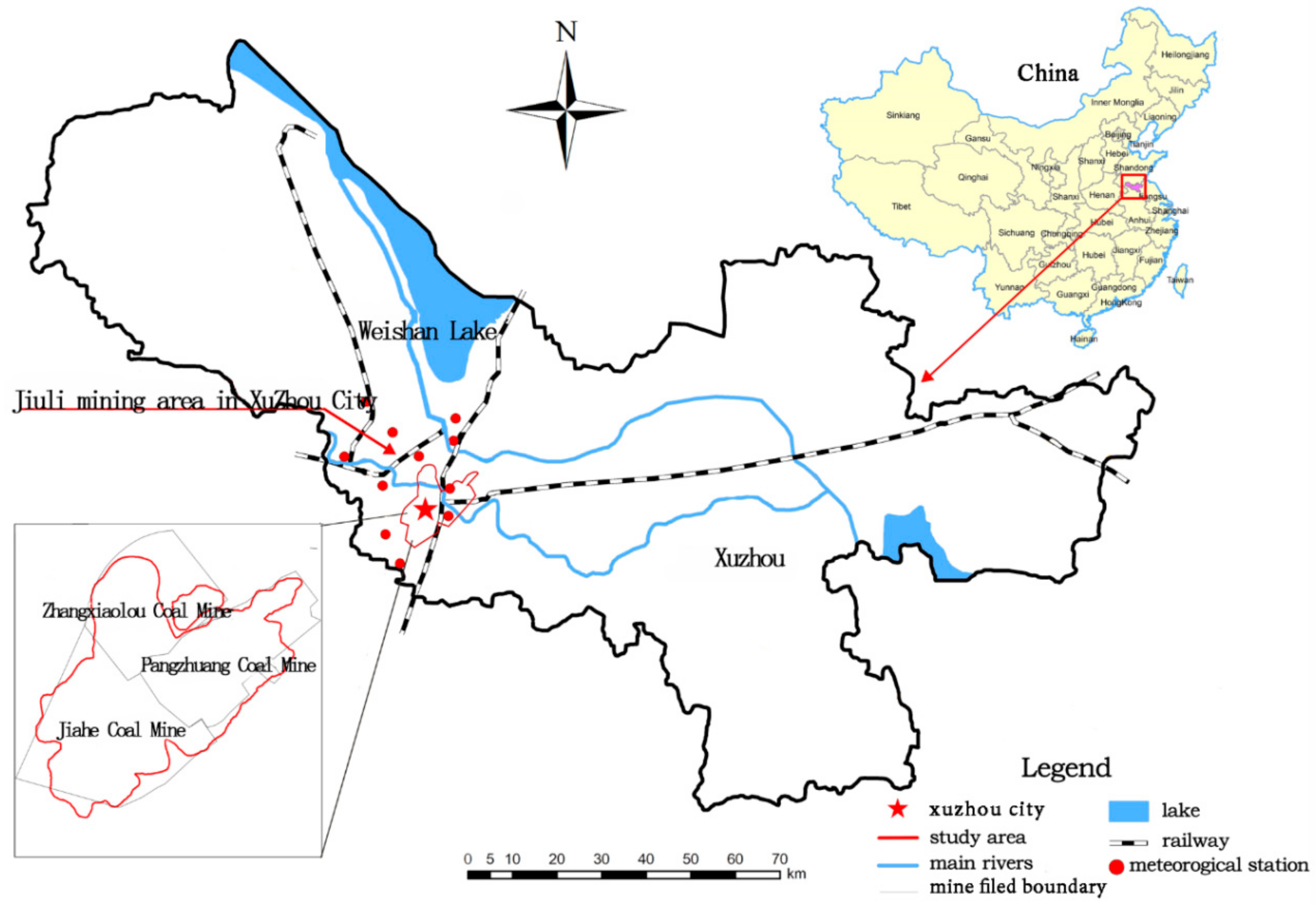
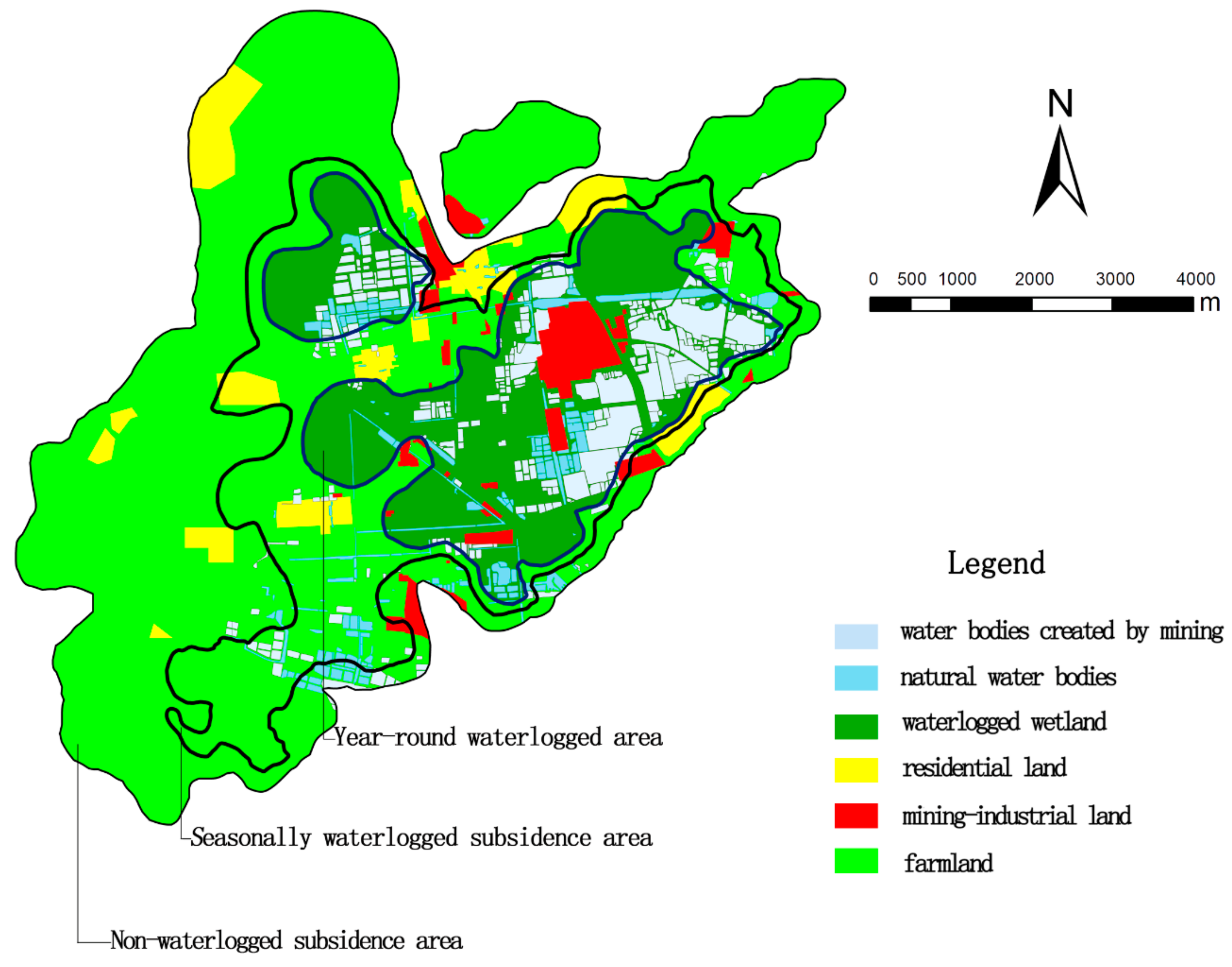
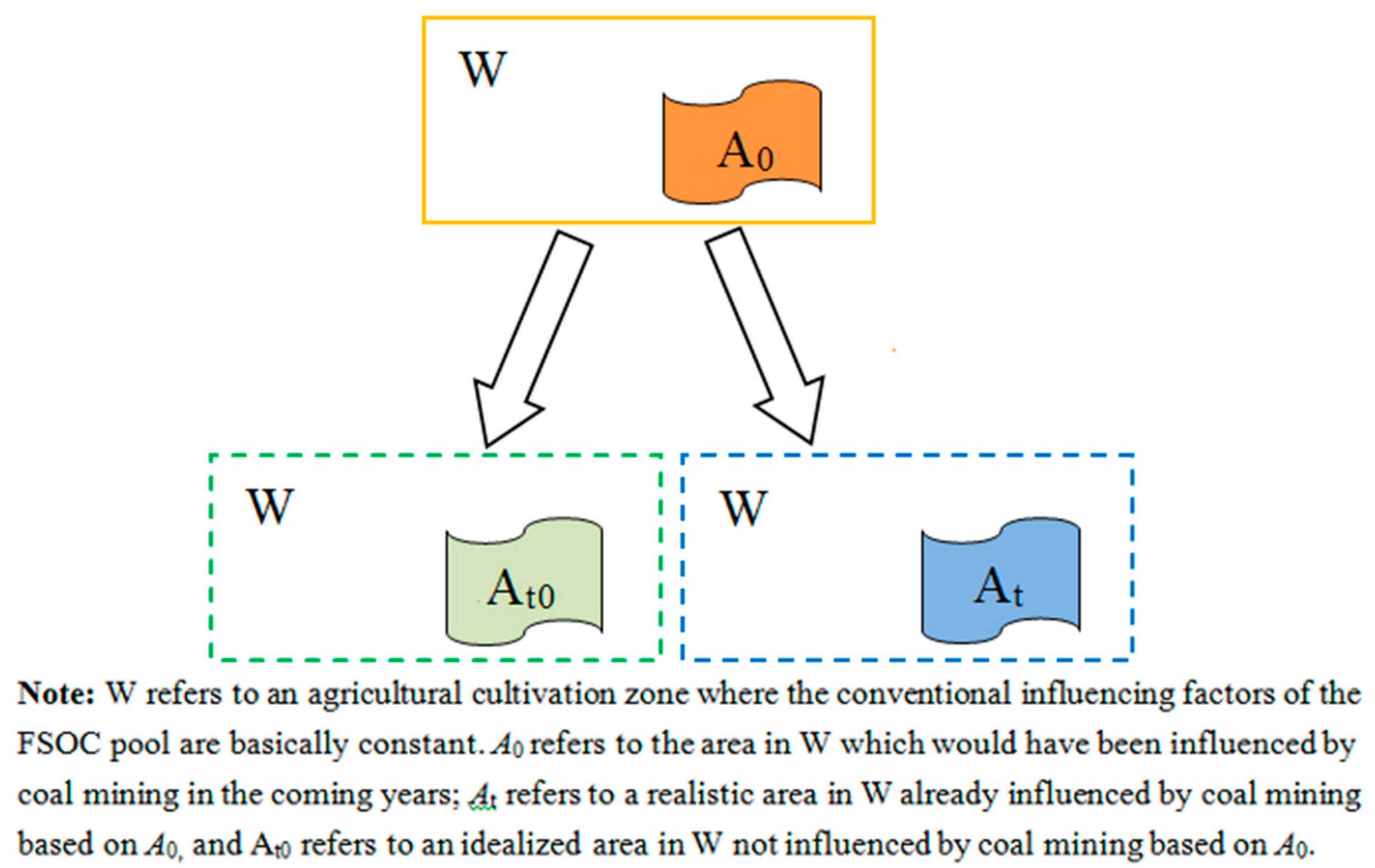
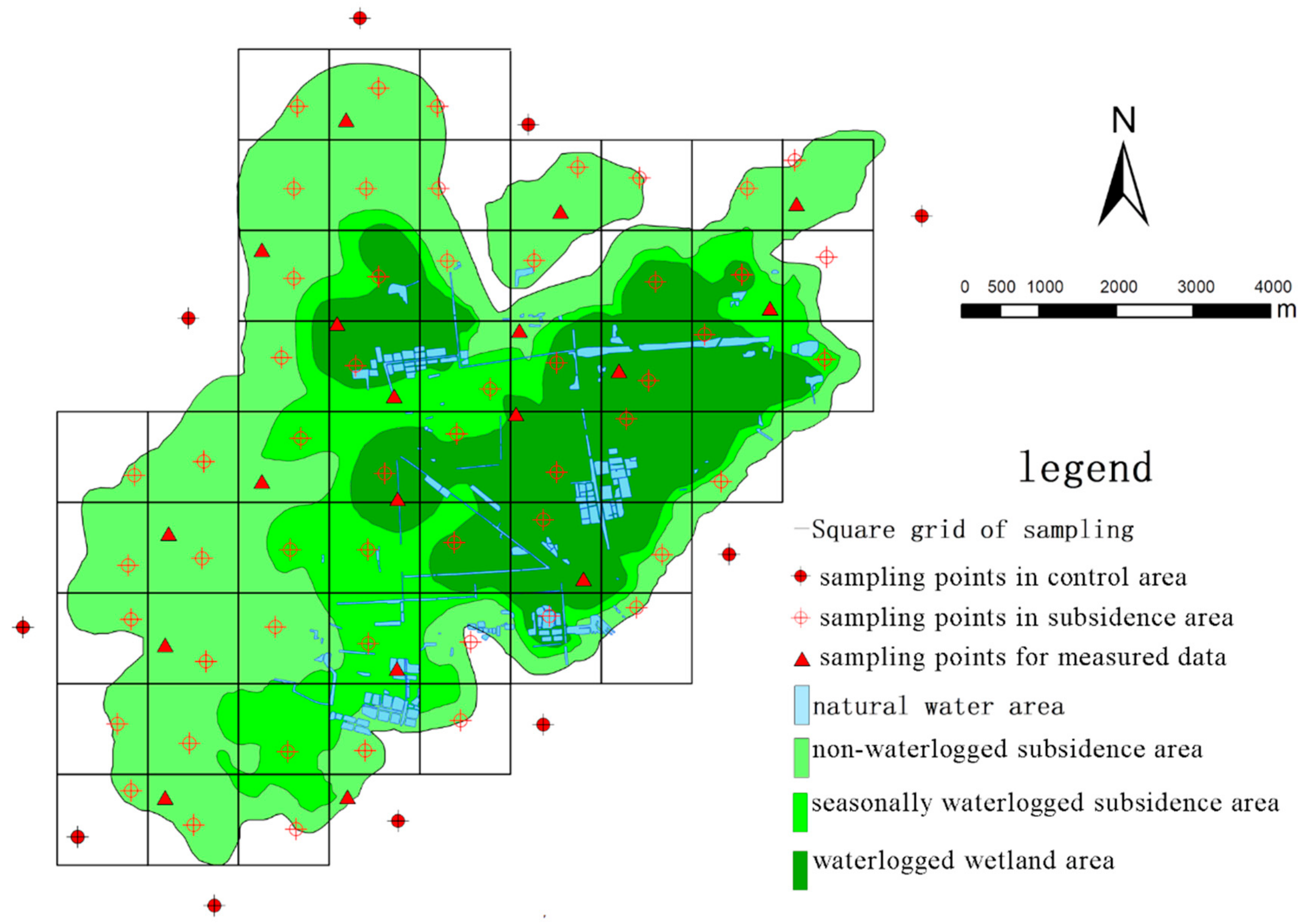
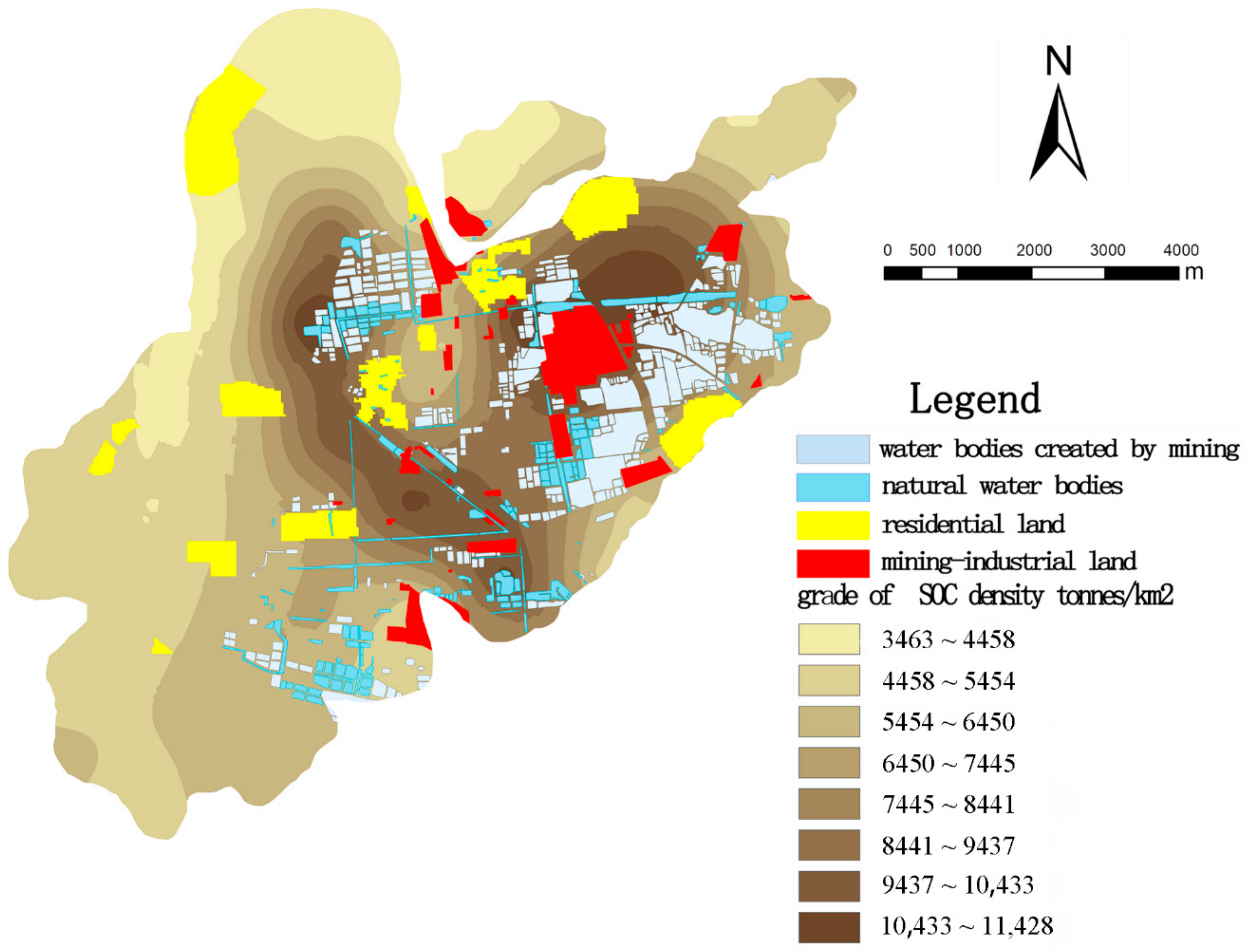
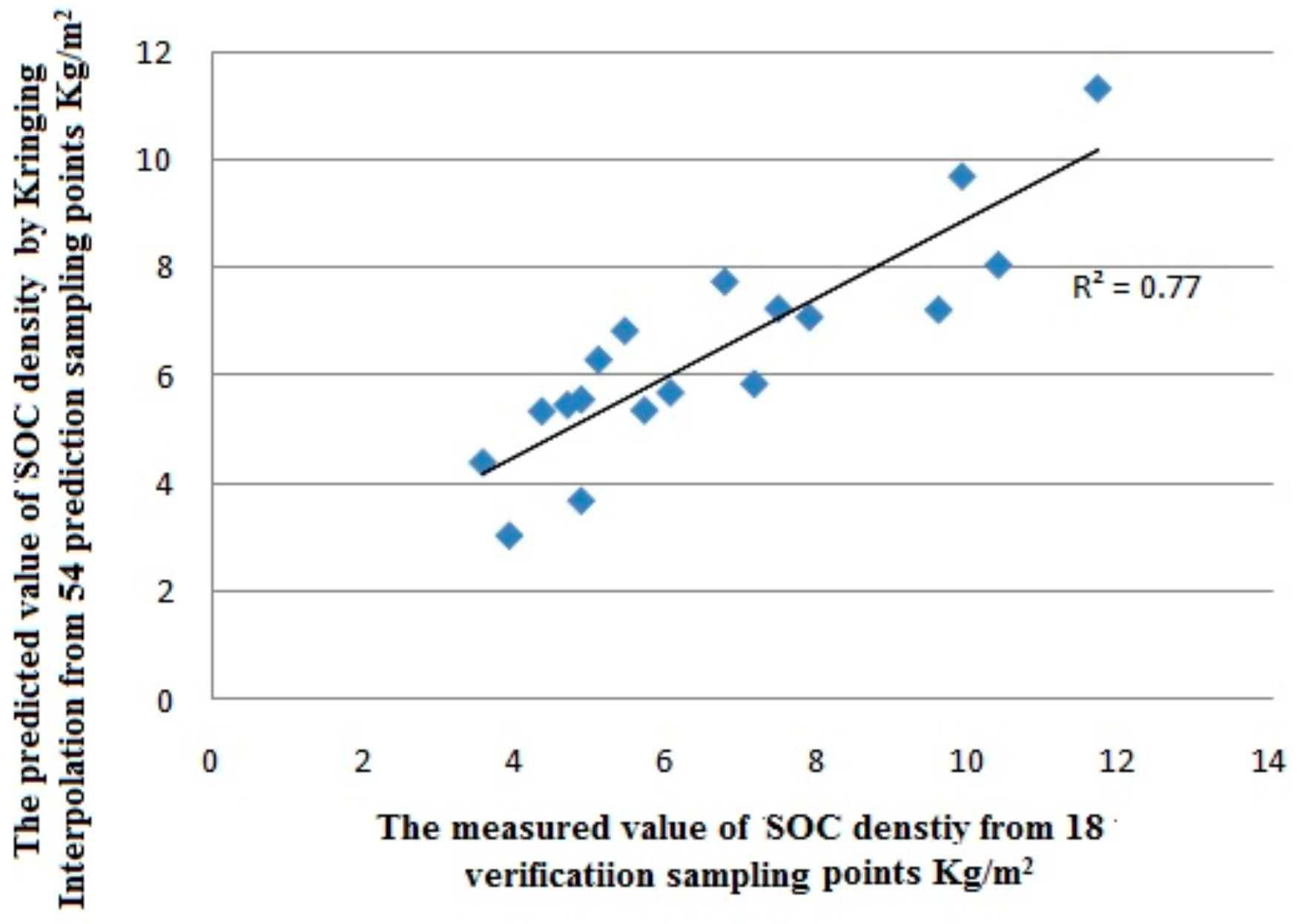
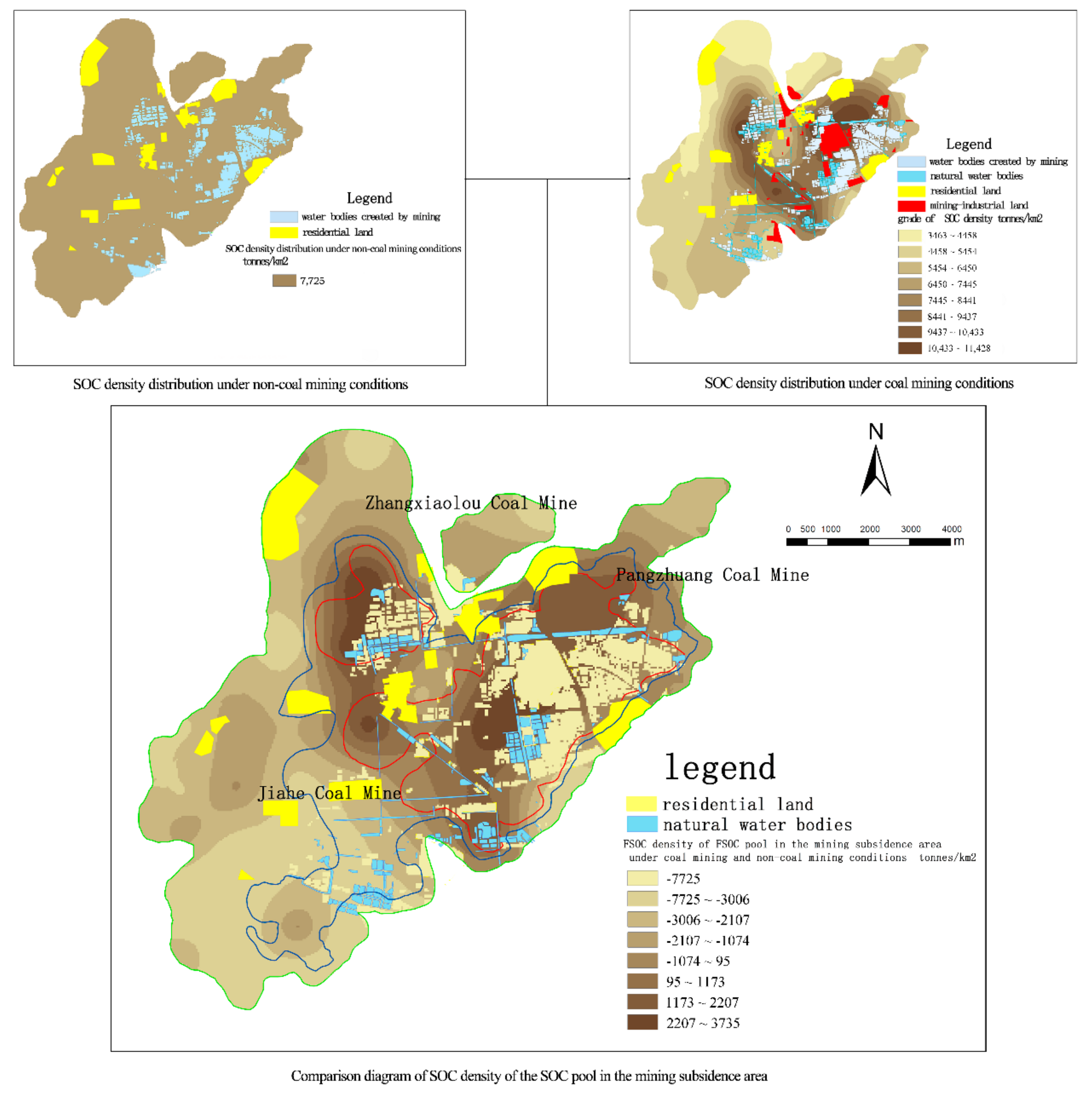
| Vegetation Feature | Model Type | Nugget C0 | Sill C0 + C | C/(C0 + C) | Range R | Coefficient of Determination R2 |
|---|---|---|---|---|---|---|
| SOC content | Exponential | 0.97 | 18.11 | 0.946 | 4237 | 0.92 |
| Soil bulk density | Gaussian | 1 × 10−5 | 0.023 | 0.996 | 1694 | 0.95 |
| Non-Waterlogged Farmland | Seasonally Waterlogged Farmland | Waterlogged Wetland | Water Bodies Created by Mining | Mining-Industrial Land | Residential Land | Natural Water Bodies | Whole Mining Subsidence Area | |
|---|---|---|---|---|---|---|---|---|
| Non-mining condition | 142,728 | 58,929 | 54,014 | 38,517 | 19,411 | 0 | 0 | 313,599 |
| Mining condition | 94,251 | 53,203 | 63,263 | 0 | 0 | 0 | 0 | 210,717 |
| Carbon effect | −48,477 | −5726 | 9249 | −38,517 | −19,411 | 0 | 0 | −102,882 |
| Carbon effect (%) | −33.96 | −9.72 | 17.12 | −100.00 | −100.00 | - | - | −32.81 |
| Researchers | Study Area | Mining Mode | SOC Pool Change | Reasons |
|---|---|---|---|---|
| Agus et al. [56] | PT. Berau Coal, Indonesia | Opencast | Before mining: 28.5 Mg C ha−1 After mining: 4.3 Mg C ha−1; Carbon loss | Vegetation and topsoil removed due to mining. SOC content decreased because of the loss of soil nutrients from the topsoil. |
| Beyhany et al. [57] | Midwestern and Appalachian coalfields of the U.S. | Opencast mining | Before mining: 210 Mg C ha−1 After mining: 130 Mg C ha−1; Carbon loss | Vegetation destroyed and abundance of soil microbes reduced due to mining. The SOC content decreased because of the decline in the capacity to decompose litter and release soil nutrients. |
| Shrestha & Lal [4] | Mining area of eastern Ohio, U.S. | Opencast mining | Before mining: 11–29 Mg C ha−1 After mining: 1.2–2.5 Mg C ha−1; Carbon loss | Mining led to the depletion of soil organic matter (SOM), increased oxidation, dilution of SOC via horizon mixing, accelerated erosion, and little or no SOC inputs from primary production during mining and the initial years of reclamation. |
| Xu et al. [58] | Jiuli Mining Area of Xuzhou City, China | Underground mining | Before mining: 560.3 tonnes C After mining: 530.9 tonnes C; Carbon loss | When surface subsidence caused by mining was unstable, the SOC losses from the upslope area were more severe due to soil erosion, and although the SOC pool had no carbon complement, soil respiration still continues and CO2 was emitted. After the surface subsidence caused by mining stabilized, SOC on the subsidence slope ran off to low-lying areas from higher areas in the mining subsidence basin due to soil erosion. |
| Cheng et al. [48] | Jiaozuo Mining Area of Henan, China | Underground mining | Decreased by 20.8–47.3 tonnes C ha−1; Carbon loss | Some ground fissures were created by underground mining. SOC from higher areas ran off into both low-lying areas and the ground fissures, thereby decreasing the SOC content in the topsoil. |
| Hou et al. [59] | Chacheng Mining Area of Xuzhou City, China | Underground mining | Before mining: 443.53 Pg C After mining: 272.68 Pg C;Carbon loss | The change in SOC was associated with land use change due to underground mining. SOC was lost to the water bodies created by mining. SOC from woodland and farmland was reduced because of ground fissures, mining subsidence, and destruction of the soil structure due to mining activity. |
© 2019 by the authors. Licensee MDPI, Basel, Switzerland. This article is an open access article distributed under the terms and conditions of the Creative Commons Attribution (CC BY) license (http://creativecommons.org/licenses/by/4.0/).
Share and Cite
Xu, Z.; Zhang, Y.; Yang, J.; Liu, F.; Bi, R.; Zhu, H.; Lv, C.; Yu, J. Effect of Underground Coal Mining on the Regional Soil Organic Carbon Pool in Farmland in a Mining Subsidence Area. Sustainability 2019, 11, 4961. https://doi.org/10.3390/su11184961
Xu Z, Zhang Y, Yang J, Liu F, Bi R, Zhu H, Lv C, Yu J. Effect of Underground Coal Mining on the Regional Soil Organic Carbon Pool in Farmland in a Mining Subsidence Area. Sustainability. 2019; 11(18):4961. https://doi.org/10.3390/su11184961
Chicago/Turabian StyleXu, Zhanjun, Yuan Zhang, Jason Yang, Fenwu Liu, Rutian Bi, Hongfen Zhu, Chunjuan Lv, and Jian Yu. 2019. "Effect of Underground Coal Mining on the Regional Soil Organic Carbon Pool in Farmland in a Mining Subsidence Area" Sustainability 11, no. 18: 4961. https://doi.org/10.3390/su11184961
APA StyleXu, Z., Zhang, Y., Yang, J., Liu, F., Bi, R., Zhu, H., Lv, C., & Yu, J. (2019). Effect of Underground Coal Mining on the Regional Soil Organic Carbon Pool in Farmland in a Mining Subsidence Area. Sustainability, 11(18), 4961. https://doi.org/10.3390/su11184961





